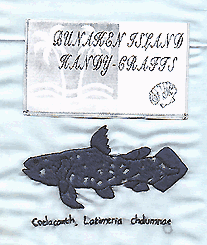Conservation:

The coelacanth population in the Comoros is estimated to be less than a thousand animals.
Moreover, submersible research by the JAGO team from Germany (lead by Hans Fricke) suggests a 30-50% decline
in the population size at GrandComore between 1991 and 1995. So the discovery of a second
population is welcome news for those interested in the conservation of coelacanths.
However, we know of only two confirmed coelacanths in Indonesia, the honeymoon fish and the
July 1998 fish. Therefore, the population must be considered to be quite small and its
discovery should in no way lessen the conservation efforts in the Comoros.
Instead, we want to do everything possible to conserve and protect both populations.

 The people and government of Indonesia have been quick to accept the responsibility of
conserving their coelacanth population. The Indonesian Institute of Sciences has hosted several
national meetings to discuss coelacanth research and conservation with the Ministry of the Environment,
and their fishery, customs, and nature conservation departments.
National pride in the coelacanth has grown thanks to numerous television and newspaper
articles. Educational posters and brochures are being distributed to schools and villages (see photo above) and
local people are now producing handicrafts featuring the coelacanth (see photo of handkerchief at right).
The people and government of Indonesia have been quick to accept the responsibility of
conserving their coelacanth population. The Indonesian Institute of Sciences has hosted several
national meetings to discuss coelacanth research and conservation with the Ministry of the Environment,
and their fishery, customs, and nature conservation departments.
National pride in the coelacanth has grown thanks to numerous television and newspaper
articles. Educational posters and brochures are being distributed to schools and villages (see photo above) and
local people are now producing handicrafts featuring the coelacanth (see photo of handkerchief at right).
What is perhaps most striking about this discovery is that it occurred in an area well-studied by
scientists for over 100 years. This illustrates how little we know about even relatively shallow,
near-shore, marine environments. Without sufficient protective measures, many species may go extinct
before we even discover them.





 The people and government of Indonesia have been quick to accept the responsibility of
conserving their coelacanth population. The Indonesian Institute of Sciences has hosted several
national meetings to discuss coelacanth research and conservation with the Ministry of the Environment,
and their fishery, customs, and nature conservation departments.
National pride in the coelacanth has grown thanks to numerous television and newspaper
articles. Educational posters and brochures are being distributed to schools and villages (see photo above) and
local people are now producing handicrafts featuring the coelacanth (see photo of handkerchief at right).
The people and government of Indonesia have been quick to accept the responsibility of
conserving their coelacanth population. The Indonesian Institute of Sciences has hosted several
national meetings to discuss coelacanth research and conservation with the Ministry of the Environment,
and their fishery, customs, and nature conservation departments.
National pride in the coelacanth has grown thanks to numerous television and newspaper
articles. Educational posters and brochures are being distributed to schools and villages (see photo above) and
local people are now producing handicrafts featuring the coelacanth (see photo of handkerchief at right).

